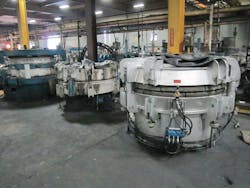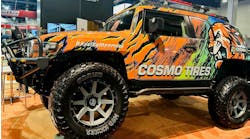Retreaders in the United States stayed busy and were able to make more money in 2013. According to the 2014 Modern Tire Dealer Facts Issue, the average price of a retreaded truck tire was $250.04 in 2013, a pricing increase of 9.6% over 2012.
In addition, 14.9 million truck tire retreads were produced, 100,000 units more than the previous year.
That was enough work to keep the 680 U.S. retread shops busy every week. But not every retreader can keep a shop busy for 40 hours by replacing their customers’ truck tires. Some of them also rely on wholesaling.
Wholesaling retreaded truck tires is a growing business that has shifted dramatically in the last 20 years. While many smaller wholesale retreaders are no longer around, wholesaling is still a good business opportunity, especially for retreaders who can find good niche markets.
Wholesalers speak out
In 1995, there were 1,385 retread shops in the U.S. They produced an average of 31 retreaded truck tires per day. In 2013, 680 retread shops produced an average of 60 retreaded truck tires per day. Retreaders today produce 93% more retreads daily with 51% fewer shops. And according to the 2013 MTD Retreaders Survey, 49% of retreaders said they planned to expand in the next 18 months; 42.9% of that 49% said they will do so by adding an additional shift.
“We saw our retreading grow a little over 5% last year,” says Brennan Pruss, business manager for Dale’s Tire & Retreading Inc. in Rapid City, S.D.
Dale’s Tire & Retreading is No. 74 on the 2013 Modern Tire Dealer Top Retreaders list.
“The wholesale side of the retreading business is what keeps you going. If you were just going to try and meet your retail demand on a daily basis, you would have a lot of ups and downs.
“You can’t turn wholesale business away because you need it there when you’re slow. That’s the difference between keeping your shop busy and having some slower days.”
“The truck tire retreading business is still strong, but the number of players has decreased over the years because it takes more and more molds to keep up,” says Willis Gill, owner of NRI Inc., dba Northwest Wholesale and Retreading in Portland, Ore. NRI is No. 9 on the top retreaders list.
[PAGEBREAK]
“We are purely wholesale, and there are not many of us left. Let’s say you sell a tire wholesale for $100. You can sell it retail for $135 to $140 and make a 30% to 40% profit margin. The wholesaler may have made 5% or 10% max. True wholesalers like us don’t make very much per tire.”
Many profitable retread wholesalers are members of the Tire Retread & Repair Information Bureau (TRIB).
“For many of our members, their wholesale business is actually growing on the independent side,” says David Stevens, TRIB’s managing director.
“You have those big manufacturers that are going directly to the fleets, and you’ll have those dealers who are still looking for other products they can sell.
“So these independent retreaders are able to go to those dealers in a wholesale model. Their wholesale businesses are definitely growing and wholesaling is still there.”
“If there is a retreader anywhere and a tire dealer nearby wants to buy their retreads from them, he’s going to wholesale to them,” says Harvey Brodsky, managing director of the Retread Tire Association. “If it looks to him like a potential source of business, he’ll create a wholesale price.”
Creating the right wholesale price is critical because both the wholesaler and the retailer have to get something out of it. For some retreaders, it becomes a challenge to keep expenses low enough to wholesale profitably.
A giant niche
Gill says that at Northwest Wholesale, giant tires are the most important part of his business.
“There are very few giant tire retreaders left because molds are a half a million dollars apiece. The new radial sizes that came out took all new molds as opposed to the old bias-ply tires. There’s probably only four or five people left in North America who retread giant tires.”
According to general manager Devon Hilton, Northwest defines a giant tire as one with a rim size of 45 inches and larger designed for the new higher horsepower machines that require more load-carrying capacities.
[PAGEBREAK]
“The loader/dozer tire size of 45/65/45 would have been the first of the giant tires,” says Hilton. “Prior to that, it was the 35/65/33 tire size (33-inch rim diameter) for the sister machines. Today, a rim size of 61 inches in diameter is common for the machines that mainly are used for hauling purposes.”
In addition to the niche of giant tires, Northwest also retreads and wholesales medium truck tires and industrial tires.
“We are more specialized,” says Gill. “Many of the Bandag dealers and so forth send us their little industrial tires to do because they don’t do them. We do specialty tires that almost no one else will do. We get a lot of rub-off from our specialty niche and that’s what keeps us going.”
Hilton believes Northwest is the last independently owned wholesale retreader in the U.S.
“We only perform our process for other dealers. We sell nothing to any end-user. We manufacture everything in-house. We do precure and everything from the smallest tires in the world to some of the largest tires in the world.”
Northwest’s customers are located west of the Mississippi River, the western half of Canada, Mexico, Australia, Japan, Hawaii and China. Hilton expects the company’s reach to continue expanding.
“It’s not really a dying business because it is ever-increasing. What is dying is the number of people who can do it. It’s a very expensive business to get into and it’s a unique one. There’s not really a school to go to learn what large OTR retreading is.”
Follow the delivery route
“We’re retailing out the front door and wholesaling out the back door,” says Dale’s Pruss. “We’re trying to get some of our associate dealers set up and stocked to sell retreads. Our distribution channel follows our normal delivery routes. We’re not focusing solely on where we can put those tires in at the wholesale level.”
He says that geographically, Dale’s could not survive strictly on its retail business.
“South Dakota only has 845,000 people total and North Dakota has 723,000. For us, wholesaling is kind of a necessary division of our business in order to keep our delivery trucks full when we’re going out on our routes.”
Pruss says that to keep those trucks full, Dale’s produces a diversified mix of retreads and tire sizes.
“We’re just not a standard mainstream size retread shop. We really cater to a mix of wholesale and retail customers. We’re going to do foam fills, industrial, grader, medium truck and skid steer tires.”
With the right niche, many retreaders are enjoying successful wholesale operations. Wholesalers like Northwest’s Gill will continue to grow by identifying more niche markets.
“We are lucky that we are so specialized in unique sizes and unique products that we can still have a niche market as purely wholesale, otherwise we’d have to get a bunch of commercial tire stores and go like everybody else. But that’s not my game. I’m not a commercial guy. I like wholesale.” ■
[PAGEBREAK]
How wholesaling saved the day for this retreader:
Acquiring a new customer base kept this business alive
Terry Westhafer, president of Central Tire Corp. in Verona, Va., says he got into wholesaling back in the late 1980s to save his business.
“We had a large common carrier trucking firm and we did 100% of their retreading. They were a pretty good-sized company.”
Westhafer was in a risky position with 100% of the business coming from one customer. Then the floor fell out from under Central Tire.
“They got sold out and 11 months later the combined company went broke. We had been doing 100 tires a day for that one fleet.”
Westhafer says he had to do something to keep the business alive and turn it around. He had an experienced, trained staff and wanted to keep as many of his people as he could.
“We decided to go into the wholesaling business. We did it a little differently than some. We had the capacity to mix and compound tread rubber on-site, so we added the equipment to make our own precure rubber.”
Westhafer says his assumption was that in every market, there is at least one very good commercial tire dealer doing a large amount of service work and remaining closely tied to a customer base. He was right, and he began locating them and bringing them on as customers.
“These dealers were putting the tires on the trucks, they weren’t just putting them on a pickup, delivering them and rolling them off a tailgate for somebody. They were actually doing the service work.”
Westhafer found wholesale customers of all sizes. Many were big organizations, but some were independents, each operating out of a garage with just one truck.
The strategy worked and Central Tire survived. Westhafer says about 50% of his business is wholesale today.
“We work a 150-mile radius of where we are in Virginia, and that’s all you can do in a day as far as sending a truck out, picking up tires and documenting them properly.”



